David Hinton’s thoroughly captivating Made In England: The Films Of Powell And Pressburger (a highlight of the 23rd edition of the Tribeca Festival) has Martin Scorsese (who is also an executive producer) as our personal guide into the wonderful world of Michael Powell and Emeric Pressburger, which includes production designers Alfred Junge and Hein Heckroth, cinematographer Jack Cardiff, and art director Arthur Lawson.
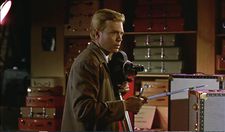 |
| David Hinton on casting Karlheinz Böhm in Peeping Tom: “It seems such an extraordinarily strange thing to do but it works so perfectly, doesn’t it?” |
Starting with The Thief Of Baghdad (co-directed by Powell with Ludwig Berger and Tim Whelan) and The Tales Of Hoffmann on a black and white TV, little Marty was already “bewitched.” Later, The Life And Death Of Colonel Blimp’s influence is vast on Scorsese, with the duel between Clive Candy (Roger Livesey) and Theo Kretschmar-Schuldorff (Anton Walbrook) inspiring the way he shot (cinematography by Michael Chapman) and cut (by Thelma Schoonmaker) the fight scene in Raging Bull, and with Deborah Kerr’s aura floating through The Age Of Innocence. We also hear that Walbrook’s impresario Lermontov in The Red Shoes shares some aspects with Robert De Niro’s Travis Bickle in Taxi Driver. “Even the eyes are choreographed” says Scorsese about the much admired filmmakers.
In 2022, Chloe Zhao, Radha Blank, Sofia Coppola, Janicza Bravo, Julie Dash, Tom Ford, Regina King, Autumn de Wilde, plus Scorsese were invited to create installations for The Metropolitan Museum of Art’s Costume Institute exhibition In America: An Anthology Of Fashion in their period rooms. Martin Scorsese took over the museum’s Frank Lloyd Wright Room, which was designed between 1912 and 1914 in the Prairie School style as a lakeside summer retreat in Minnesota. The clothes given to him for the exhibit were by the great American couturier Charles James and to stage his one-frame movie he chose John Stahl’s Leave Her To Heaven as inspiration. And yet, the result for me was supremely Powell and Pressburger - a room in a real museum and out of this world, a timeless space of beauty where anything could happen and anything that is true is as possible as it is fleeting.
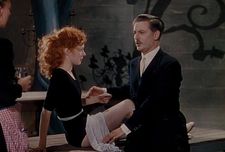 |
| Victoria Page (Moira Shearer) with Boris Lermontov (Anton Walbrook) in The Red Shoes |
Upcoming screenings at the Museum of Modern Art in New York for their comprehensive Cinema Unbound: The Creative Worlds of Powell and Pressburger retrospective include A Matter Of Life And Death, The Small Back Room, Gone To Earth, The Elusive Pimpernel, The Tales Of Hoffmann, The Volunteer, Ill Met By Moonlight, The Battle Of The River Plate, Oh…Rosalinda!!, and concluding with The Red Shoes. A number of Michael Powell highlights include Peeping Tom, Bluebeard’s Castle, and the spectacle Martin Scorsese mentions in the documentary as a big early influence on him becoming a filmmaker, The Thief Of Bagdad. A large selection of early Powell films are also in the series.
From London, David Hinton joined me on Zoom for an in-depth conversation on Made in England: The Films of Powell and Pressburger.
Anne-Katrin Titze: Very nice to meet you!
David Hinton: Nice to meet you too!
AKT: The documentary got my heart racing from the very first clips, it is so beautiful. You capture so much of the power of Powell and Pressburger. I think Martin Scorsese says that their films are “a constant source of energy.” Did that energy drive you through the making of your film as well?
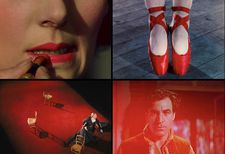 |
| Red in Made In England: The Films Of Powell And Pressburger |
DH: It did, yeah! In a way the process for me has gone on a very long time, because I first met Michael Powell myself in the 1980s. I made a film with him for television in 1986. So my relationship to him and to the movies goes back nearly 40 years now. In some ways this documentary has been like 40 years in the making, a very long time.
AKT: “The films grow deeper with you,” says Scorsese, and he is very right. In a way the documentary is a portrait of three film artists and not just the two, including Martin Scorsese. He is revealing so much about his own process [of making and watching movies] as well. Did you feel that way?
DH: Absolutely, yeah. I love what he says about the films’ subconscious, the way his relationship with those movies started in his childhood. I always think Scorsese must have been such an unusual child. Because he talks about watching Tales Of Hoffmann on TV every night of the week for a week when he was ten years old or something. And I think when I was ten years old that film would have bored me out of my brains! It’s an opera!
So the fact that he sat there as a child and absorbed Tales Of Hoffmann and that it launched in his subconscious and still every day now informs how he thinks about relationships between music and camera. He’s a very unusual guy, Scorsese. But I love that story. It says so much about how films can be not just something that you go and see at the cinema and you’ve forgotten the next day, but something that you can live with for the whole of your life.
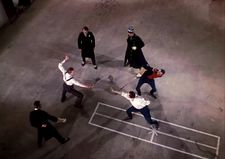 |
| The duel between between Clive Candy (Roger Livesey) and Theo Kretschmar-Schuldorff (Anton Walbrook) in The Life And Death Of Colonel Blimp |
AKT: Yes, films can stay with you, especially the films by The Archers. From my own experience, some filmmakers I discovered in retrospectives, where I saw a lot of films together in a row. Never so with them. Like Marty, I have seen some on television as a child, and then step by step at different times another crossed my path. I still haven’t seen their Fledermaus, Oh... Rosalinda!! The films have a life of their own, an energy of their own, as if they wait in different places and you discover them when you need them.
DH: That’s so true! That’s really well put! I agree with you absolutely. I too, throughout my life, I encountered each one in a different way, a very piecemeal way. It wasn’t like when I was a young man I went to a Powell/Pressburger retrospective. It’s been exactly as you describe. You discover more and more of them the longer you live. And then they stay with you for as long as you live.
AKT: A few quotes by Scorsese speak about the otherworldly quality of their movies. He says he was “bewitched” by them as a child. Then he says they “set traps to capture magic.”
DH: Yes!
AKT: There is again an extra, that “they wanted to achieve a heightened intensity only possible through artifice.” That heightened intensity, that magic, is the basis of storytelling and has been for centuries. And they capture some of it. Does that make sense to you?
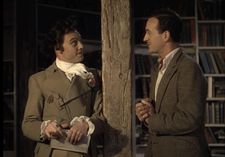 |
| Conductor 71 (Marius Goring) consults with Peter Carter (David Niven) in A Matter Of Life And Death |
DH: It makes complete sense to me. You know, one of the fascinating things about them is that that is precisely what did make them “un-British,” certainly when I was a young man. What was great about British film was social realism. And we have a great tradition of that. I think that’s why Powell/Pressburger really went out of fashion in the Sixties and the Seventies. Because precisely that taste for fantasy and for artifice and for magic - these were not regarded as British qualities or the strength of what British film was.
AKT: Even during the war, their very successful war films were doing something different from others. In the consolation, inspiration, and possibility of renewal they provided! A Matter of Life and Death, together with I Know Where I’m Going - these two might be my favourite ones of their films! Plus The Red Shoes! I have to say all three.
DH: Ha! Good choices, yes.
AKT: I go with those three. They have a kind of healing quality as well.
DH: I think that’s particularly true of A Matter Of Life And Death, isn’t it? What an extraordinary film to make at the end of the war! And actually making [The Life And Death Of Colonel] Blimp in the middle of the war! A film that’s basically satirising the British military in 1942. I mean, the audacity of it and the gutsiness of doing that, it’s incredible. We just love that audacity in there.
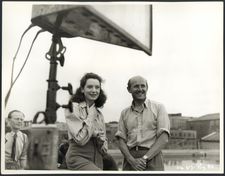 |
| David Hinton on casting Deborah Kerr (here with Michael Powell on set): “She was only 20 when they started making Blimp. Giving her all these three roles and then her doing them so brilliantly!” |
AKT: Anton Walbrook was the alter ego for both of them, wasn’t he? Appearing in so many films, as Lermontov [in The Red Shoes] and earlier in Blimp. Did you get that sense from them that he often was their alter ego?
DH: Oh totally, yeah. Particularly in Blimp I feel that the Walbrook character is Emeric and the Clive Candy character is Michael. Without a doubt. In fact, there is a scene in Blimp where Walbrook tells the story of how he arrived in Britain and I think that very much echos Emeric’s own experience. There are definitely autobiographical elements in there from Emeric’s point of view. The chemistry of those two characters and the balance between them, I think that’s very much about Michael and Emeric’s relationship.
AKT: In 49th Parallel, Walbrook displays so much honour in his stature.
DH: I think in 49th Parallel, Walbrook is definitely Emeric’s spokesman. He is making the speeches that Emeric would like to make himself [Jonathan Coe in his novel Mr. Wilder And Me, now on its way to be made into a movie by Stephen Frears, produced by Jeremy Thomas, has a chapter on Emeric Pressburger in Berlin].
AKT: The casting is interesting in general, the German backgrounds, or Austrian actually, of a number of the actors. Having Karlheinz Böhm as Powell’s Peeping Tom! He came from the Sissi movies in the 1950s, where he played Emperor Franz-Josef, opposite Romy Schneider as Sissi [spelled historically inaccurately with double-s, unlike Frauke Finsterwalder’s recent Sisi & I]. Then he is Peeping Tom and Powell cast himself as the father! Incredible casting choices!
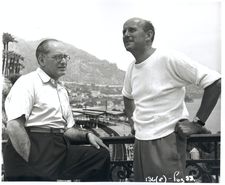 |
| David Hinton on the films of Emeric Pressburger and Michael Powell: “You discover more and more of them the longer you live. And then they stay with you for as long as you live.” |
DH: Yeah, the casting of Böhm in Peeping Tom is one of the most incredible pieces of casting I have ever encountered in my life. It seems such an extraordinarily strange thing to do but it works so perfectly, doesn’t it? He’s such a sympathetic actor in that film so it creates this incredible tension, because he is doing these unforgivable, appalling deeds. But you can’t help but identify with him and like him. What an extraordinary choice! But it worked so brilliantly for the film.
AKT: And the casting of Deborah Kerr, of course!
DH: The risks he took! Deborah Kerr, she was only 20 when they started making Blimp. Giving her all these three roles and then her doing them so brilliantly! And then Moira Shearer!
AKT: Oh yes!
DH: She was a ballerina, she wasn’t an actress. And Michael insisted, we must have a ballerina! And again that just paid off so magnificently.
AKT: It did very much so! I don’t know when you were filming the Scorsese commentary and if you perhaps saw at the Metropolitan Museum of Art, about two years ago, that he was part of the Costume Institute’s exhibition [In America: An Anthology of Fashion]. He took over the Frank Lloyd Wright room at the museum and he staged an elegant funeral gathering in there, with mannequins dressed in Charles James. I had to think about A Matter of Life and Death, seeing it [Scorsese said his tableau was influenced by midcentury melodramas and the vibrant three-strip Technicolor of the 1940s].
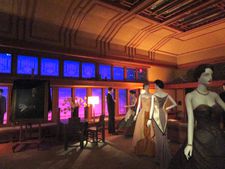 |
| Martin Scorsese’s installation in the Met’s Frank Lloyd Wright Room for the Costume Institute in New York |
DH: Oh I didn’t know that he did that! That’s fascinating!
AKT: It was incredibly powerful for me. There were different filmmakers working with different rooms and periods in the museum.
DH: I wish I had seen that! That sounds fantastic.
AKT: When did you film the commentary with Scorsese? Was it all in one go, his narration?
DH: What we did was first of all a sound-only version of his narration. Actually, we were incredibly lucky there. He did that during Covid. Like all of us, Scorsese was stuck at home. He wasn’t able to work as he normally would. But that meant that he was able to give us a huge amount of time and energy and he did this wonderful sound-only version of the narration, which we used for the early edits. Then towards the end of the filmmaking process, we came back to New York and shot the pieces on-camera. That was last summer, I think.
AKT: Famed production designer Alfred Junge and the art direction, we have to talk about that! It’s very prominent in their films and I love that you gave it quite a lot of space in the documentary, because that look is so much what their films are also about. He is the best!
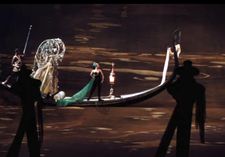 |
| Ludmilla Tchérina as Giulietta in The Tales Of Hoffmann |
DH: Oh I’m glad you think that! We’ve been in touch with Sylvia Junge, who is his daughter. She was incredibly helpful on the documentary and gave us access to a lot of Alfred’s work. Of course, ideally we’d also want to give a lot of time to [production designer] Hein Heckroth, who designed the later films. It’s quite an interesting moment in Powell/Pressburger’s career when Junge stopped designing the films and Heckroth took over. So The Red Shoes and Tales of Hoffmann was very much kind of Heckroth’s sensibility. More painterly than Junge. Junge is more architectural in his thinking. Heckroth’s is more of a painter’s spirit.
AKT: Apropos painterliness, I very much like how you split the screen, how you quarter the screen several times, and we see in depth all the wonderful details. I was reminded, seeing these, how much my own taste to this day was influenced by Powell/Pressburger films. These [I am holding up my Mansur Gavriel Square Toe Ballerinas] are my favourite summer shoes right now!
DH: Fantastic! Oh great!
AKT: It’s very true that films don’t die, they remain and live with us. So thank you for reminding us of all their great works!
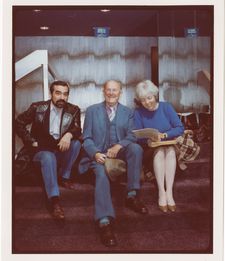 |
| Martin Scorsese with Michael Powell and Thelma Schoonmaker |
DH: It’s been a joy! It’s a real joy talking with you about it. I’m really happy that you like the documentary and got so much out of it, that’s great.
AKT: I hope the film has a long journey and will be seen by many!
DH: It’s been a pleasure talking to you! Thank you very much indeed!
Made in England: The Films of Powell and Pressburger opened on Friday, July 12 at the Quad Cinema in New York.
Cinema Unbound: The Creative Worlds of Powell and Pressburger runs through Sunday, July 31 at the Museum of Modern Art in New York and is organised at BFI by Robin Baker, Head of Cultural Partnerships, James Bell, Senior Curator of Fiction Film, and Claire Smith, Senior Curator of Special Collections, and at MoMA by Dave Kehr, Curator, and Olivia Priedite, Film Program Coordinator, Department of Film.






















